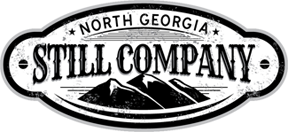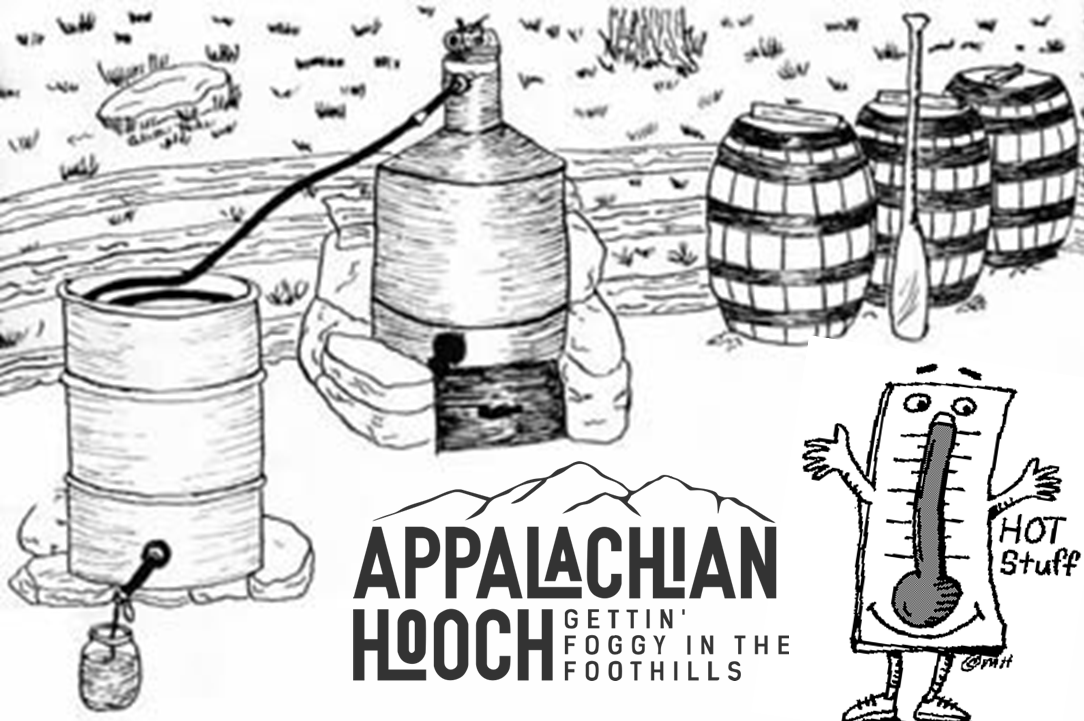Distillation and condensing temperature, does it really matter?
It’s a notion most have heard multiple times – “hot run, hot liquor” or “cold run, smooth liquor.” Is that really the case? Or is this, like some other things in the moonshine world, just an old wives’ tale passed down from generation to generation?
If you’ve been running liquor for very long you inherently have a sense of the temperatures at which the azeotropic blend you created in your mash/wash will evaporate alcohols; these will re-condense to create the spirit we all know and love.
Science tells us the boiling point of pure ethanol is 174° F at sea level. (Yeah, elevation changes things slightly – and we can cover that in the future.) Remember though, our mashes and washes are not 100% pure ethanol.
Why does that matter? Let’s cover azeotropic blends real quick…
Azeotropic blends are best described as “a consistent boiling blend.” To be an azeotrope the mixture must consist of at least two different substances; better put, at least two different elements or compounds. Oil and water mixed for instance, are not azeotropic because the two separates from one another easily and rapidly. 1
Every azeotropic blend has a defined boiling point, either less than the boiling point temperature of the highest concentration individual ingredient (positive azeotrope), or greater (negative azeotrope). The most well-known example of an azeotrope is – you guessed it, ethanol and water. 2
Our mashes and washes are a “positive azeotrope” with over 50% water, so that 174° F boiling point of pure ethanol increases. For example, a mixture of 10% ethanol and 90% water has a boiling point of about 197° F. 3 Less than pure water, more than pure ethanol.
Combine that information along with the fact that each still will run and produce differently based on your individual run style, and the fact that our washes contain other components such as acetone, methanol, etc… the waters really begin to get “cloudy” on proper temperature – distilling pun intended. The key thing to take away from the above is that each mash and wash will react differently based on the inherent blend you achieved.
Therefore, I despise those diagrams indicating temperatures at which “foreshots, heads, hearts and tails” will distill and appear. They are nothing more than pointless references (if they can even be classified as references). Don’t get me started on thermometers either… while helpful, only use them purely as a reference to maintain a steady run and monitor your heat up, NOT as a hard and fast rule.
Speaking of those heads, hearts and tails, temperature can absolutely have an impact on these. Running your still too fast or too hot will guarantee that the temperature of your azeotropic blend increases to the point that more “other” vapor is being released faster than or equal to ethanol vapor. This results in low proof, smeared cuts, and early tails. (Yes, some smearing happens regardless, but you will exacerbate that effect with a hot and fast run.)
As many of you may know from my social media presence, I like to follow the “slow and steady wins the race” approach. Heat up slow, run slow, at least until you fully learn what your equipment is capable of. Nothing good ever happens fast in this hobby and I believe that also applies to running your still.
With that out of the way, lets touch a little bit on the condensing side of things.
Once we use the previous information to get a handle on what temperature our mash/wash will boil, we then get an idea of what temperature our condenser realistically needs to be to condense that vapor. In a perfect world, anything lower than the boiling point of our mash/wash will begin to condense the vapor into good ol’ shine. There’s a problem though… it isn’t that simple. With so many different types of condensers on the market today with differences of volume, surface area etc., there is again much more to consider.
Most home distillers I know are always shooting for a super cold worm/condenser. (I am guilty of it myself – just check out my first TikTok videos.) In my opinion some of us have it in our head that colder condensers will produce better liquor, and we will burn through enough ice to cool a mid-west elk kill in an attempt to achieve that standard.
With my runs this summer, I didn’t achieve that standard. My average worm bath temperature was more than 90° F. Full disclosure – I didn’t have a choice. I draft from a farm pond, and in doing so mother nature has full control over my cooling water temperature.
Did the run taste “hot?” Nope. “Fiery?” Not a bit. The only thing noticed was some early tails, which were directly related to running during such a hot day at my “normal” speed and power settings; purely my mistake and not at all related to the temperature of my condensing water. I should have taken into consideration the entire distilling environment I was in that day.
This prompted me to research more into these topics and ultimately inspired this article.
As long as your worm is not producing vapor from the spout, I am under the belief that your condensing water is fine, no matter the temperature. I recommend taking a mirror and holding it in front of your worm spout; if it steams up, you’re pushing vapors and should change something or stop the run immediately. We all know what can happen if that continues. (Insert Fire Dept. sirens here.)
I have found no evidence during research, runs, or otherwise to make me think that the temperature of my worm in any way impacts the smoothness or quality of my distillate. As long as you have enough temperature differential to completely condense that vapor to liquid.
Now with that said, you can absolutely have an undersized condenser. A condenser not long enough or with not enough cooling volume or surface area will significantly impact the speed and amount at which you are able to produce/condense, if you are able to condense at all. Again, the mirror check will answer that question for you. The fix may be as simple as slowing down the run or decreasing your cooling water temperature, depending on the equipment you’re working with.
Maybe your condenser is smaller, but with colder water it fully condenses as expected? Maybe your condenser is oversized, and allows you to push that cooling water temperature upwards of 100° F? As long as you are safely condensing ALL vapor, run what you have at whatever temperature works for you and achieves the stream you’re looking for.
If you go through your run faster than your equipment can handle, your temperature will inevitably increase, so I can somewhat understand the old adage “hot run, hot liquor.” While if you slow down and your temperature remains rather consistent and proper for your equipment, “cold run, smooth liquor” could very well make sense.
But Hooch… how fast is too fast? Let your still answer that question.
I don’t understand… how will my still tell me that? Through temperature.
But I thought temperature didn’t matter? It doesn’t. What matters is how your still is handling and how your run is reacting to that temperature.
How will I know if my still can “handle” it? By learning your still and being in-tune with your run. It may take some trial and error, and that’s OK.
Are you dizzy from all the circles? I am.
What I do know is that distilling is more of an art than any of us can ever fathom. One can pound science, chemistry, and numbers until they are “blue in the face.” In the end the most important part of the process comes down to the “touch” of the individual distiller and how well that distiller knows and runs his or her equipment.
There’s so much more that could be said on what I mention. From azeotropic blends, temperatures, cuts, proper condenser sizing and how it all can have an impact on your product – feel free to do your own research on those topics. This is one hobby that if you stop learning, it is time to move on.
In the meantime, I recommend using temperature during distillation for what it’s worth, a good reference point. Learn and listen to your still and follow its guidance and I guarantee that you’ll be ignoring that thermometer in no time.
Practice your “touch,” learn your equipment, and sharpen your senses – because that’s the only thing that sets you as a distiller and the spirits you produce apart.
-Hooch
REFERENCES
What’s an Azeotrope and Why Should I Care? | MicroCare
Distillation Temperature – Clawhammer Supply
“Hooch” is a social media content creator and first-generation moonshiner from the heart of moonshine country: the foothills of the Appalachian Mountains. While more of a “home-distiller” than the traditional “moonshiner”, he is known for his mixture of modern distilling technology with backwoods techniques, helping to merging the gap between the former and next generation moonshiner. Hooch also co-hosts UN-TAXED Podcast and has his own signature still available from North Georgia Still Company.
Follow him on TikTok @appalachianhooch and find him on Facebook “Appalachian Hooch”. Be sure to also check out UN-TAXED Podcast, available on YouTube and your favorite podcast apps.
For more information or to provide feedback, feel free to reach out to “Hooch” via email, [email protected] or any of the social media platforms.
Thoughts and opinions expressed in this article are that of the author ONLY and are not representative of any business, entity or individual listed therein.


Heck yeah!
LET’s GO !!!!!!!
Wow. Really puts things into perspective on learning your equipment thanks HOOCH!
I’m going to back off my ice imput on the next go round, and test your theory. Perhaps I’ll be able to cut down on my ice usage. Thanks for the advice
Love the thought of its all variable, what a good read
Very great info
Makes sense! All you hear is this temp does this, that temp does that… not once has there been an explanation like that. Even the higher boiling temp of the wash… I’ve started to listen more to the equipment and this gives understanding.
Excellent info.
This is great information for everyone to read! I too feel like people read way to far into thermometers and try to run the still through the thermometer… that being said thermometer placement can cause confusion… they work great as a reference….. Shine On!
That’s all a thermometer is. A reference. Too many people ask what temp to make cuts etc.
Looking forward to reading more. great article. Really looking forward to reading more books. cool. I really enjoy reading a thought provoking article. Also, thanks for allowing me to comment!